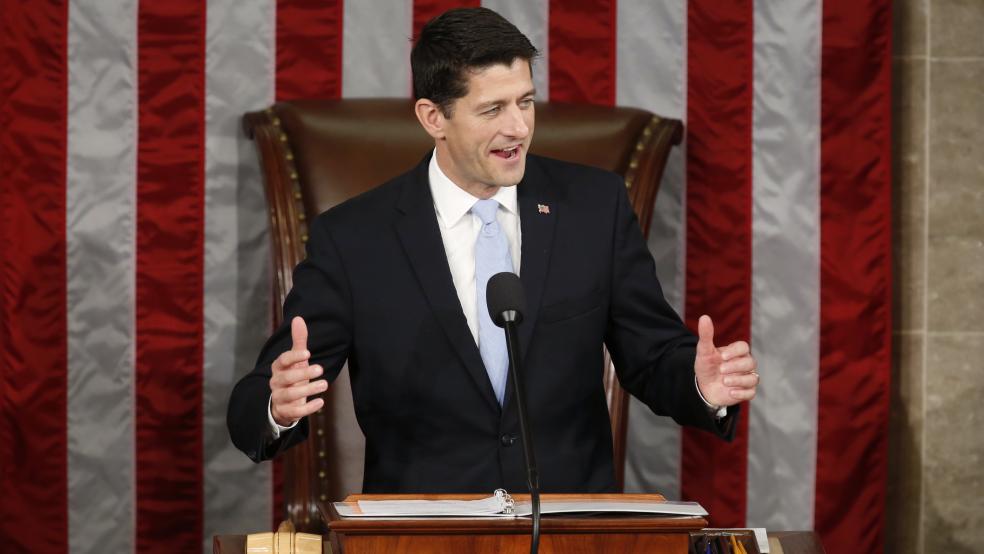To hear House Republican leaders tell it, the GOP budget for fiscal 2017 contains cures for nearly every U.S. financial ill.
“It lays before the American people a positive vision for how we can solve our fiscal, economic, and national security challenges through reforms that would grow our economy and hold Washington accountable” Budget Committee chair Tom Price (R-GA) said in a statement Wednesday night after the panel approved the $1.07 trillion spending plan in a 20 to 16 vote.
Related: Paul Ryan Is Taking a $30 Billion Gamble With the GOP’s Budget
“This is a budget that balances the budget, pays off the debt, honors our military with equipment that they need,” Speaker Paul Ryan (R-WI) said Thursday during a press conference. “It calls for tax reform. It repeals Obamacare. It does everything we need to do on the entitlement side to move people from welfare from work and to pay off this debt.
“So we think this is a very good budget.”
Truth be told, the proposed budget continues the age-old fiscal gamesmanship that observers have come to expect from both parties. It assumes revenues and savings that are unlikely to ever materialize, while laying out greater expenditures in the future.
Despite leadership claims to the contrary, there is a widely held belief among many federal budget watchers that Price had to resort to budgetary smoke and mirrors to create a pathway to a balanced budget without raising taxes.
Here are three of the gimmicks the House GOP is relying on:
1. The promise of savings.
The trillion-dollar roadmap sticks to the two-year budget deal struck last year by congressional leaders, with a level of spending that is unacceptable to fiscal hawks, including the roughly 40 members of the House Freedom Caucus, who want spending cut by at least $30 billion.
Related: Why the GOP’s Budget Plans Are Going Off the Rails
A previous proposal by Price was to accompany the budget with a “sidecar” of real spending cuts, but the lawmakers ditched that. Instead, they approved a Republican amendment that encourages House leadership to find $30 billion in cuts in future fiscal bills and urges them to attach a separate deficit reduction measure to other must-pass legislation if the Senate doesn’t take up the savings package.
The Senate isn't expected to act on either the budget or the accompanying package of cuts.
2. Gaming the war fund.
President Obama asked for $74 billion for the Defense Department’s Overseas Contingency Operations (OCO) account, also known as the war fund. The House GOP budget matches that figure, but assumes that $23 billion will go toward the Pentagon’s basic budget needs.
“By increasing the amount of normal defense funding provided through the OCO designation while keeping the same total amount for OCO, the budget is effectively underfunding true OCO needs requested by the Defense Department by $18 billion,” says an analysis by the Committee for a Responsible Federal Budget.
The sleight of hand has enraged defense hawks, who argue it shortchanges the military, as well as fiscal hawks, who believe that the difference will likely be made up through a supplemental spending request.
3. That it can pass.
More so than last year, when an intraparty brawl between defense and fiscal hawks over OCO funding nearly derailed the budget process, the fate of the fiscal 2017 resolution is grim, with the very real chance it won’t even receive a vote on the floor of the House.
Related: Paul Ryan’s Three Perilous Paths to a Budget Deal
Consider the budget panel vote. Two Republicans, both members of the Freedom Caucus, joined Democrats in voting against the resolution, and a handful of others who supported it in committee said they would oppose it on the floor.
Ryan can’t lose more than 28 votes to pass the budget, which is usually a party-line vote. Making it harder to round up the votes is the looming Easter recess, with lawmakers not set to return to Washington until April 12.
Ryan is being tight-lipped about the path forward.
“We don't have an answer to that question yet. We're going to be discussing this with our conference on how best to proceed,” he said, adding that he envisions “a lot of budgets coming to the floor” from groups like the congressional Black and Progressive caucuses, the conservative House Republican Study Committee and others.
Asked if he agreed with recent efforts to revive “No Budget, No Pay” legislation for congressional lawmakers – something GOP leaders used as a bludgeon against Democrats for failing to move a budget resolution when they controlled the Senate -- Ryan, a former budget chair who has not twisted arms to get a blueprint done, replied: “I think we should pass a budget, plain and simple. I'll just leave it at that.”





